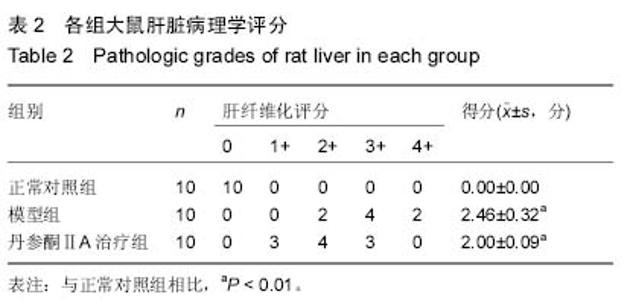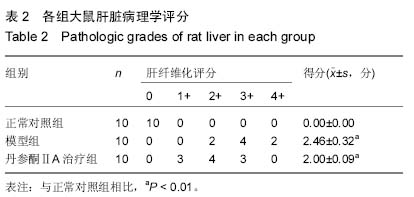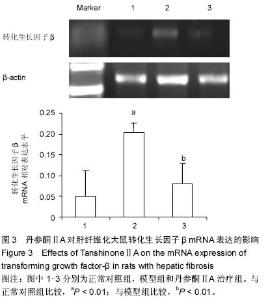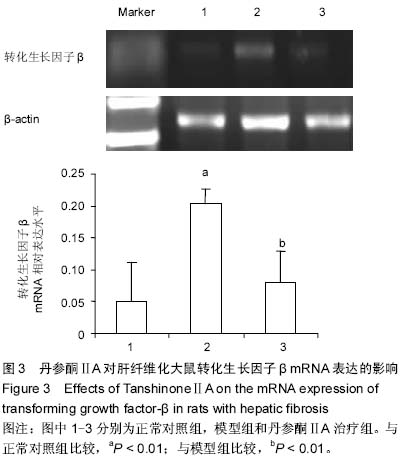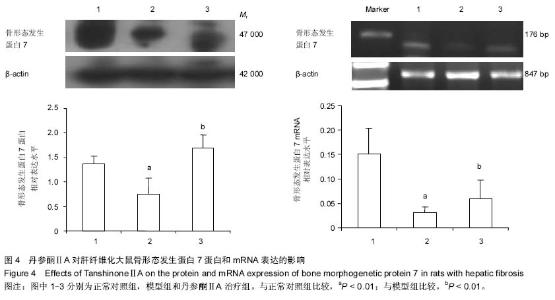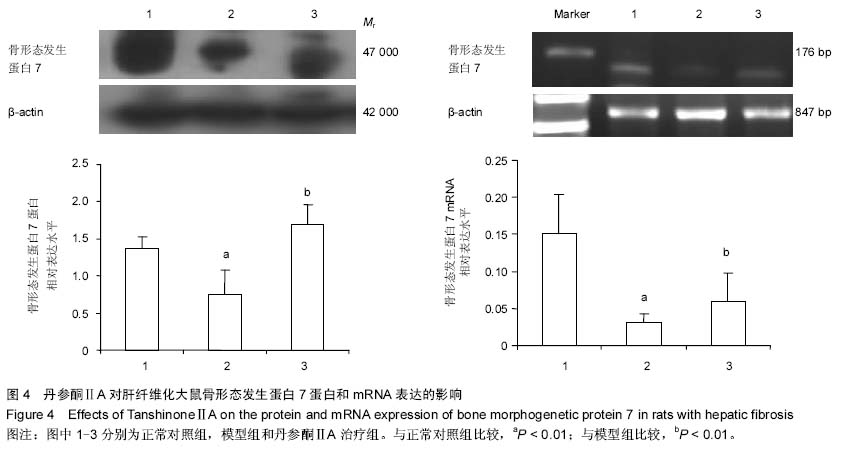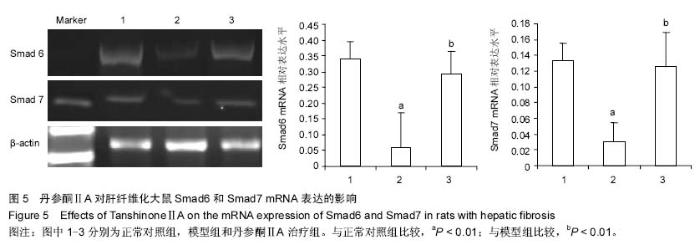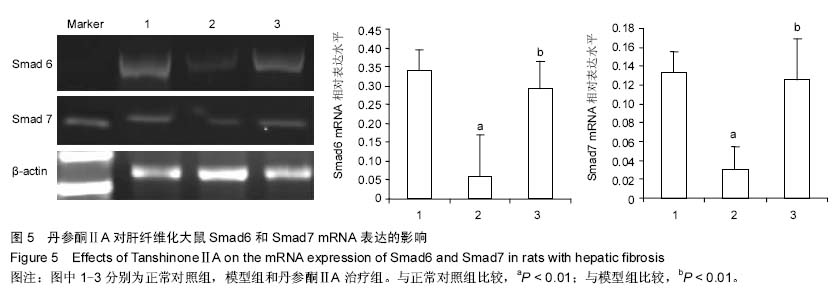Chinese Journal of Tissue Engineering Research ›› 2015, Vol. 19 ›› Issue (27): 4345-4350.doi: 10.3969/j.issn.2095-4344.2015.27.015
Previous Articles Next Articles
Effects of TanshinoneⅡA on expression of transforming growth factor-β/Smads signaling pathway related factors in the liver tissue of rats with hepatic fibrosis
Zhang Cai-hua, Li Cong, Li Hua-jun, Guo Lian-ying, Jia Yu-jie
- Department of Pathophysiology, Dalian Medical University, Dalian 116044, Liaoning Province, China
-
Online:2015-06-30Published:2015-06-30 -
Contact:Jia Yu-jie, M.D., Professor, Department of Pathophysiology, Dalian Medical University, Dalian 116044, Liaoning Province, China -
About author:Zhang Cai-hua, M.D., Lecturer, Department of Pathophysiology, Dalian Medical University, Dalian 116044, Liaoning Province, China. -
Supported by:the Natural Science Foundation of Liaoning Province of China, No. 201102055
CLC Number:
Cite this article
Zhang Cai-hua, Li Cong, Li Hua-jun, Guo Lian-ying, Jia Yu-jie. Effects of TanshinoneⅡA on expression of transforming growth factor-β/Smads signaling pathway related factors in the liver tissue of rats with hepatic fibrosis [J]. Chinese Journal of Tissue Engineering Research, 2015, 19(27): 4345-4350.
share this article
| [1] Tsukada S, Parsons CJ, Rippe RA. Mechanisms of liver fibrosis. Clin Chim Acta. 2006;364(1-2):33-60. [2] Schuppan D, Kim YO. Evolving therapies for liver fibrosis. J Clin Invest. 2013;123:1887-1901. [3] Castera L. Assessing liver fibrosis. Expert Rev Gastroenterol Hepatol. 2008;2:541-552. [4] Ikeda H, Yatomi Y. Autotaxin in liver fibrosis. Clin Chim Acta. 2012;413:1817-1821. [5] Mann J, Mann DA. Transcriptional regulation of hepatic stellate cells. Adv Drug Deliv Rev. 2009;61:497-512. [6] Miao CG, Yang YY, He X, et al. Wnt signaling in liver fibrosis: progress, challenges and potential directions. Biochimie. 2013;95:2326-2335. [7] 张彩华,姜妙娜,李骢,等.肝复康药物血清对肝星状细胞核因子-κB及I、Ⅲ型胶原表达的影响[J].中西医结合肝病杂志,2012, 21(2):100-103. [8] Roderburg C, Luedde M, Vargas Cardenas D, et al. miR-133a mediates TGF-β-dependent derepression of collagen synthesis in hepatic stellate cells during liver fibrosis. J Hepatol. 2013;58(4):736-742. [9] Arauz J, Zarco N, Segovia J, et al. Caffeine prevents experimental liver fibrosis by blocking the expression of TGF-β. Eur J Gastroenterol Hepatol. 2014;26(2):164-173. [10] Li F, Ma N, Zhao R, et al. Overexpression of miR-483-5p/3p cooperate to inhibit mouse liver fibrosis by suppressing the TGF-β stimulated HSCs in transgenic mice. J Cell Mol Med. 2014;18(6):966-974. [11] Margoni A, Fotis L, Papavassiliou AG. The transforming growth factor-beta/bone morphogenetic protein signalling pathway in adipogenesis. Int J Biochem Cell Biol. 2012; 44(3):475-479. [12] Lee HS, Son WC, Ryu JE, et al. Standardized salvia miltiorrhiza extract suppresses hepatic stellate cell activation and attenuates steatohepatitis induced by a methionine- choline deficient diet in mice. Molecules. 2014;19:8189-8211. [13] Guan CW, Jin J, Li J, et al. Tanshinone IIA protects against triptolide-induced liver injury via Nrf2/ARE activation. Yao Xue Xue Bao. 2013;48(9):1397-1402. [14] 牛雪花,华海涌,郭文建,等.丹参酮IIA磺酸钠治疗晚期血吸虫病肝纤维化的效果观察[J].中国血吸虫病防治杂志,2013,25(2): 137-140. [15] 毛忠懿,肖敏,吴雄健,等.丹参酮ⅡA、苦参素联合治疗对慢性乙型肝炎患者肝功能及肝纤维化指标的影响[J].实用临床医学, 2014,(2):21-23. [16] Huang W, Li L, Tian X, et al. Astragalus and Paeoniae radix rubra extract inhibits liver fibrosis by modulating the transforming growth factor-β/Smad pathway in rats. Mol Med Rep. 2015;11(2):805-814. [17] Zhang CH, Wang YF, Chen H, et al. Protective effect of the herbal medicine Gan-fu-kang against carbon tetrachloride- induced liver fibrosis in rats. Mol med report. 2013;8(3):954-962. [18] Lou JL, Jiang MN, Li C, et al. Herb medicine Gan-fu-kang attenuates liver injury in a rat fibrotic model. J Ethnopharmacol. 2010;128:131-138. [19] Li CX, Luo J, Li L, et al. The collagenolytic effects of the traditional Chinese medicine preparation, Han-Dan-Gan-Le, contribute to reversal of chemical- induced liver fibrosis in rats. Life Sci. 2003;72:1563-1571. [20] Dijksterhuis JP, Petersen J, Schulte G. WNT/Frizzled signaling: receptor-ligand selectivity with focus on FZD-G protein signaling and its physiological relevance. Br J Pharmacol. 2014;171(5):1195-1209. [21] Watson MR, Wallace K, Gieling RG, et al. NF?kappaB is a critical regulator of the survival of rodent and human hepatic myofibroblasts. J Hepatol. 2008;48:589?597. [22] Ji L, Xue R, Tang W, et al.Toll like receptor 2 knock-out attenuates carbon tetrachloride (CCl4)-induced liver fibrosis by downregulating MAPK and NF-κB signaling pathways. FEBS Lett. 2014;588(12):2095-2100. [23] Tang LX, He RH, Yang G, et al. Asiatic acid inhibits liver fibrosis by blocking TGF-beta/Smad signaling in vivo and in vitro. PLoS One. 2012;7(2):e31350. [24] Xu TT, Jiang MN, Li C, et al. Effect of Chinese traditional compound, Gan-fu-kang, on CCl(4)-induced liver fibrosis in rats and its probable molecular mechanisms. Hepatol Res. 2007;37:221-229. [25] Zeng S, Chen J, Shen H. Controlling of bone morphogenetic protein signaling. Cell Signal. 2010;22(6):888-893. [26] Nishinakamura R, Sakaguchi M. BMP signaling and its modifiers in kidney development. Pediatr Nephrol. 2014;29(4):681-686. [27] Zeisberg M, Kalluri R. Reversal of experimental renal fibrosis by BMP7 provides insights into novel therapeutic strategies for chronic kidney disease. Pediatr Nephrol. 2008;23(9): 1395-1398. [28] Freedman BI, Bowden DW, Ziegler JT, et al. Bone morphogenetic protein 7 (BMP7) gene polymorphisms are associated with inverse relationships between vascular calcification and BMD: the diabetes heart study. J Bone Miner Res. 2009;24(10):1719-27. [29] Weiskirchen R, Meurer SK.BMP-7 counteracting TGF-beta1 activities in organ fibrosis. Front Biosci (Landmark Ed). 2013; 18:1407-1434. [30] 何培元,王明娟,张聪,等.BMP-7/Smad6信号通路在酒精性肝损伤大鼠模型中的调节作用[J].临床和实验医学杂志,2014,13(17): 1393-1396. [31] Zimmermann A. Regulation of liver regeneration. Nephrol Dial Transplant. 2004;19(Suppl 4):S6-S10. [32] Cutroneo KR. TGF-beta-induced fibrosis and SMAD signaling: oligo decoys as natural therapeutics for inhibition of tissue fibrosis and scarring. Wound Repair Regen. 2007;15 Suppl 1: S54-S60. |
| [1] | Chen Ziyang, Pu Rui, Deng Shuang, Yuan Lingyan. Regulatory effect of exosomes on exercise-mediated insulin resistance diseases [J]. Chinese Journal of Tissue Engineering Research, 2021, 25(25): 4089-4094. |
| [2] | Chen Yang, Huang Denggao, Gao Yuanhui, Wang Shunlan, Cao Hui, Zheng Linlin, He Haowei, Luo Siqin, Xiao Jingchuan, Zhang Yingai, Zhang Shufang. Low-intensity pulsed ultrasound promotes the proliferation and adhesion of human adipose-derived mesenchymal stem cells [J]. Chinese Journal of Tissue Engineering Research, 2021, 25(25): 3949-3955. |
| [3] | Yang Junhui, Luo Jinli, Yuan Xiaoping. Effects of human growth hormone on proliferation and osteogenic differentiation of human periodontal ligament stem cells [J]. Chinese Journal of Tissue Engineering Research, 2021, 25(25): 3956-3961. |
| [4] | Sun Jianwei, Yang Xinming, Zhang Ying. Effect of montelukast combined with bone marrow mesenchymal stem cell transplantation on spinal cord injury in rat models [J]. Chinese Journal of Tissue Engineering Research, 2021, 25(25): 3962-3969. |
| [5] | Gao Shan, Huang Dongjing, Hong Haiman, Jia Jingqiao, Meng Fei. Comparison on the curative effect of human placenta-derived mesenchymal stem cells and induced islet-like cells in gestational diabetes mellitus rats [J]. Chinese Journal of Tissue Engineering Research, 2021, 25(25): 3981-3987. |
| [6] | Hao Xiaona, Zhang Yingjie, Li Yuyun, Xu Tao. Bone marrow mesenchymal stem cells overexpressing prolyl oligopeptidase on the repair of liver fibrosis in rat models [J]. Chinese Journal of Tissue Engineering Research, 2021, 25(25): 3988-3993. |
| [7] | Liu Jianyou, Jia Zhongwei, Niu Jiawei, Cao Xinjie, Zhang Dong, Wei Jie. A new method for measuring the anteversion angle of the femoral neck by constructing the three-dimensional digital model of the femur [J]. Chinese Journal of Tissue Engineering Research, 2021, 25(24): 3779-3783. |
| [8] | Meng Lingjie, Qian Hui, Sheng Xiaolei, Lu Jianfeng, Huang Jianping, Qi Liangang, Liu Zongbao. Application of three-dimensional printing technology combined with bone cement in minimally invasive treatment of the collapsed Sanders III type of calcaneal fractures [J]. Chinese Journal of Tissue Engineering Research, 2021, 25(24): 3784-3789. |
| [9] | Qian Xuankun, Huang Hefei, Wu Chengcong, Liu Keting, Ou Hua, Zhang Jinpeng, Ren Jing, Wan Jianshan. Computer-assisted navigation combined with minimally invasive transforaminal lumbar interbody fusion for lumbar spondylolisthesis [J]. Chinese Journal of Tissue Engineering Research, 2021, 25(24): 3790-3795. |
| [10] | Hu Jing, Xiang Yang, Ye Chuan, Han Ziji. Three-dimensional printing assisted screw placement and freehand pedicle screw fixation in the treatment of thoracolumbar fractures: 1-year follow-up [J]. Chinese Journal of Tissue Engineering Research, 2021, 25(24): 3804-3809. |
| [11] | Shu Qihang, Liao Yijia, Xue Jingbo, Yan Yiguo, Wang Cheng. Three-dimensional finite element analysis of a new three-dimensional printed porous fusion cage for cervical vertebra [J]. Chinese Journal of Tissue Engineering Research, 2021, 25(24): 3810-3815. |
| [12] | Wang Yihan, Li Yang, Zhang Ling, Zhang Rui, Xu Ruida, Han Xiaofeng, Cheng Guangqi, Wang Weil. Application of three-dimensional visualization technology for digital orthopedics in the reduction and fixation of intertrochanteric fracture [J]. Chinese Journal of Tissue Engineering Research, 2021, 25(24): 3816-3820. |
| [13] | Sun Maji, Wang Qiuan, Zhang Xingchen, Guo Chong, Yuan Feng, Guo Kaijin. Development and biomechanical analysis of a new anterior cervical pedicle screw fixation system [J]. Chinese Journal of Tissue Engineering Research, 2021, 25(24): 3821-3825. |
| [14] | Lin Wang, Wang Yingying, Guo Weizhong, Yuan Cuihua, Xu Shenggui, Zhang Shenshen, Lin Chengshou. Adopting expanded lateral approach to enhance the mechanical stability and knee function for treating posterolateral column fracture of tibial plateau [J]. Chinese Journal of Tissue Engineering Research, 2021, 25(24): 3826-3827. |
| [15] | Zhu Yun, Chen Yu, Qiu Hao, Liu Dun, Jin Guorong, Chen Shimou, Weng Zheng. Finite element analysis for treatment of osteoporotic femoral fracture with far cortical locking screw [J]. Chinese Journal of Tissue Engineering Research, 2021, 25(24): 3832-3837. |
| Viewed | ||||||
|
Full text |
|
|||||
|
Abstract |
|
|||||




